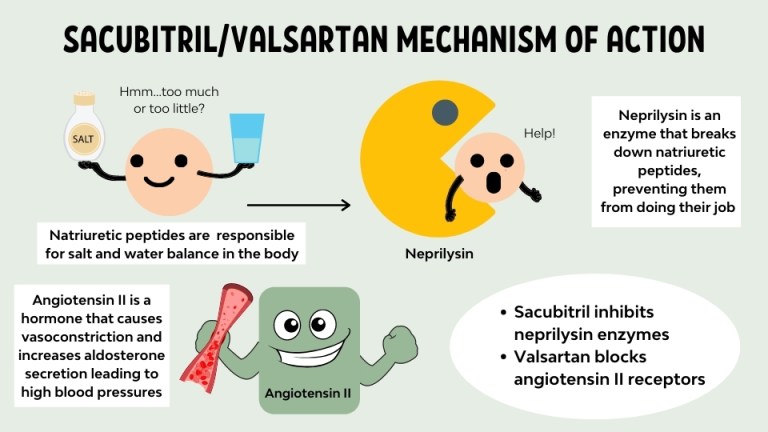
Topics
don't stop learning now
Follow us on social media:
Entresto®
Angiotensin receptor-neprilysin inhibitors (ARNI) is a new class of heart failure medications. The first drug in this class is Entresto® (sacubitril/valsartan). It is a combination medication comprised of a neprilysin inhibitor (sacubitril) and an angiotensin II receptor blocker (valsartan).

Mechanism of action:
To understand the mechanism of action, you must first understand the following biological processes:
Our body has natural enzymes and hormones that regulate blood pressure and fluid balance.
Natriuretic peptides help maintain sodium and water balance. When this balance is disturbed (say….due to heart failure), levels of natriuretic peptides rise in response to help restore homeostasis. Neprilysin is a naturally occurring enzyme that breaks down natriuretic peptides and prevents them from doing their job.
Study Tip: Natriuretic sounds like the word diuretic, which is precisely what it is, a ‘natural diuretic’ peptide that helps your body get rid of excess sodium and fluid. Neprilysin ends in ‘-lysin’, hinting that it is an enzyme that lyses or breaks down other substances.
Angiotensin is a protein hormone that causes vasoconstriction, leading to increased blood pressure and aldosterone synthesis, causing subsequent increases in water retention.
Study Tip: the prefix ‘angio-‘ means vessel in Greek, so together angiotensin means a hormone that makes your blood vessels tense.
How the medications work (refer to the visual):
- Sacubitril is a prodrug that inhibits neprilysin thus preventing it from breaking down natriuretic peptides. This mechanism leads to an increase in vasodilation and diuresis as levels of natriuretic peptides rise.
- Valsartan directly blocks angiotensin II receptors inhibiting angiotensin II from binding onto the receptors and causing vasoconstriction and aldosterone release.
Indications:
- Reduce the risk of cardiovascular death and hospitalization in patients with chronic heart failure and reduced ejection fraction.
- Sacubitril/valsartan is to be used in place of an ACEI or ARB and in conjunction with other standard, heart-failure treatments (e.g., beta blocker, aldosterone antagonist).
Side Effects:
A fun mnemonic to help you remember the side effects is PARCH.
- Potassium increase
- Angioedema
- Renal Failure
- Cough
- Hypotension
Clinical Pearls/Education:
- If the patient was previously on an ACEI, ensure that they are off of it for 36 hours before initiating sacubitril/valsartan to lower the risk of angioedema.
- Brain natriuretic peptide (BNP) will not be a reliable marker of heart failure exacerbations in patients taking this drug because sacubitril/valsartan inhibits the breakdown of natriuretic peptide leading to an elevation in BNP.
- Because neprilysin also breaks down angiotensin II, inhibiting neprilysin will result in an accumulation of angiotensin II. For this reason, a neprilysin inhibitor cannot be used alone; it must always be combined with an ARB (such as valsartan) to block the effect of the excess angiotensin II.
- The recommended starting dose is sacubitril 49 mg/valsartan 51 mg twice per day. It should be doubled every 2 to 4 weeks as tolerated, up to the target dose of sacubitril 97 mg/valsartan 103 mg orally twice per day.
- Reduce the starting dose to sacubitril 24 mg/valsartan 26 mg in patients with:
- Renal impairment (eGFR < 30 mL/min)
- Moderate hepatic impairment (Child-Pugh class B)
- Previously on a low dose of on ACEI/ARB or not currently on an ACEI/ARB
- Administer without regard to meals.
References:
Check out our FREE Heart Failure Drug Guide here!



